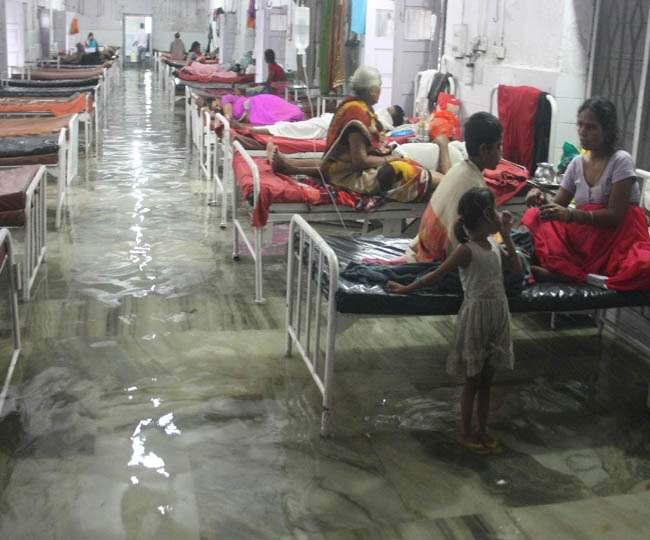Nalanda Medical College and Hospital, Bihar’s top government medical hospital has turned into an artificial aquarium after continuous rainfall in Patna. Water has rushed into wards and the Intensive Care Unit (ICU). Fish, snakes, frogs, scorpions etc. can be abundantly seen in the water. The hospital administration has left patients and attendants unattended, even the doctors and other staff have stopped visiting.
This is the story of development in the state. Every year, Patna faces heavy rainfall and every year, the local government seems paralysed. The city’s drainage system is inefficient, choked or broken everywhere. Instead of taking any steps towards helping the hospital and its patients, authorities are just waiting for the rain to stop and water to automatically drain out.
Patna received a moderate rainfall of 132.1 mm in between 8.30am on Saturday and 8.30am on Sunday. This was the first ever monsoon rain the state capital after lean and dry months June and July. Rice farmers faced the worst ever water crisis, 2/3rd of their saplings have already dried out.
Urban population load and unprecedented mass migration have deteriorated Patna’s natural urban ecosystem leading to concretization of almost 99% wetlands in the city. It has been facing an appalling state of waterlogging after just a few hours of heavy rainfall and there seems to be no end to the situation. Constructions of buildings and apartments, as well as undergoing projects of state roads, highways and flyovers in and around the city, are human-made risks worsening the situation further. For the last two and half decades, Patna has been expanding explosively. Residents have been bypassing legal norms assigned under the Public Works Department of the State Government and have constructed homes indiscriminately. The government has overlooked this explosive expansion, and there has been a state of policy paralysis at the urban governance level to work on an Integrated Urban Development Plan.
Between 1990 to 2005, there was a state of zero urban governance. And after 2005, Patna turned into a ‘real estate haven’ when a katha (1360 ft) of land started valuing up to ₹20-60 lakh. Local private property owners then started selling their land and earning huge profits. If the government had controlled the sale and purchase of land resources, maybe today Patna wouldn’t have been facing such waterlogging.
Bihar has been blessed with wetlands, a dream for its agricultural economy for the fertile land it provides. Today, four major perennial wetlands are waterlogged zones. The first zone is extreme east of Patna Saheb and south to the New Bypass 30, near and around Mahatma Gandhi Setu. What was once a major part of unidentified and un-demarcated wetlands acting as a ‘water sink’ for a new urban sprawl, has now been taken over in the urbanisation boom. The situation is likewise for the whole of the Kankarbagh area and habitations in its proximity. The landscape north of the Bailey Road connecting to Danapur and the Army Cantonment is fully occupied by sky-rocketing apartments and homes with no or poor drainage.
The third zone is the Ganga Diara zone. Ganga has been shifting northward, leaving a vast piece of land. This land would have been an easy route to divert mass water during the monsoon. However, high profile individuals with political, judicial, bureaucratic and business backgrounds have now occupied this Gangetic bed, leaving no way to drain rainwater into Ganga.
The fourth zone is Meethapur Farms, an area that was also a part of unidentified and demarcated wetlands offering a livelihood to locals surrounding the habitat through fisheries and Trapa (Singhara) farming. Apart from livelihood, it was also acting as an area to disperse excess water for Meethapur and areas in proximity. The Bihar government destroyed the precious ecology by developing a bus stand and other educational institutions on it. The step was a big policy blunder, as it ignored the natural environment and ecology for blind development measures. It is disappointing to see how the Bihar Government has been treating our wetland ecosystems which are widely known for their rich productivity and ‘disaster risk reduction’.
Government policies do not address the growing instability of the hydrological cycle in the state. Every household has submersible boring, and the government has failed to supply potable drinking water. The government is only watching as a spectator.
